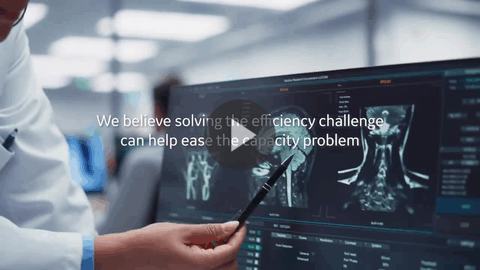Building a stronger future for healthcare requires consistently pursuing innovative ways to improve lives in the moments that matter. A significant touchpoint in the patient care pathway, medical imaging continues to evolve with advanced technology and solutions to support clinicians’ efforts to diagnose, treat, and monitor disease. As health systems strive to promote health equity, provide better access to high-quality patient care, and improve patient outcomes, radiology departments face increased demands for imaging access amid shortages and burnout in radiology staff.
Modifying the radiology workflow can help to address these challenges. Some areas of improvement could include intuitively designed imaging systems and software. Sophisticated artificial intelligence (AI) algorithms can help to streamline the workflow with efficiencies to accommodate higher patient volumes, provide quality checks during the imaging exam, and facilitate clinical decision support within a radiologists’ review. A new era is upon us in radiology and healthcare, with AI imaging solutions integrating data and clinical care across the health enterprise and throughout the patient journey.
GE HealthCare continues to deliver intelligently efficient innovations in radiology that support clinicians in medical imaging. Such innovations include advancing imaging technology and the supporting systems that enable a collaborative care environment, helping to achieve access to medical imaging when and where patients need it. GE Healthcare’s commitment to building on these innovations with state-of-the-art technology and AI-based solutions will continue to support clinicians’ efforts to diagnose and treat disease and provide customers with enterprise-level support to implement a successful and sustainable future. These efforts have the potential to accelerate and streamline workflows, increase operational imaging efficiencies, improve clinical outcomes, and ease patients’ access to care.
“We’re executing on our vision to focus on health system efficiency, the digitalization of healthcare, and integrating precision diagnostics with therapeutics to improve outcomes,” said Scott Miller, Chief Marketing Officer of imaging at GE HealthCare. “By solving these market needs, we will enable a more resilient and sustainable healthcare practice, while growing access to care.”
Improving medical imaging access
Limited or no access to care is one of the primary factors related to health disparities, which are often caused by socially determined circumstances and can result in poor patient outcomes. The inability to access important components in the care path, such as medical imaging, can have a dramatic effect on health outcomes. Advances in medical imaging have greatly improved the accuracy of disease screenings and aid clinicians in diagnosing diseases earlier. Without these advances, these diseases might not be detected until they reached a stage that’s much more life-threatening.[1] Despite its importance in the care pathway, many patients have insufficient access to medical imaging for a variety of reasons.
Improving access to care and advancing health equity continues to be a global priority. Combining the healthcare industry’s efforts in these areas with growing innovations in AI and advanced imaging technology is a fortuitous opportunity to deliver the right care to the right patient at the right time and place—delivering precision diagnostics and progressing the goal of health equity for all. GE HealthCare is committed to improving access to medical imaging, driving awareness, and creating solutions that can help break through barriers to increase access for more patients where they seek care.
Personalizing healthcare with precision diagnostics and therapeutics
In addition to enabling increased access to care, advances in precision imaging are enabling clinicians to move away from a traditional, one-size-fits-all perspective and toward individualized healthcare decisions for their patients. From diagnosis to treatment, tools such as imaging data, AI in imaging, advanced clinical applications, biomarkers, and therapeutics are especially poised to help inform a clinician’s personalized approach to each patient’s care.
Precision imaging assists in diagnosing disease with improved accuracy, better delineating disease subtypes, defining prognoses, and informing treatments for oncological and non-oncological disorders. Precision imaging is descriptive, predictive, and integrative—effectively moving acquired data to clinical insights.[2] Imaging data is a critical component of the clinical information that can enable precision diagnostics and therapeutics, leading to newer techniques such as theranostics.
With more precise and integrated care, imaging diagnostics and therapeutics are impacting clinical outcomes across the patient care journey, in areas such as prostate cancer, breast cancer, and more.
Precision diagnostics and therapeutics
Streamlining the radiology workflow to boost imaging efficiency and capacity
Advanced medical imaging exams with complex scanning protocols and processing requirements are performed on a regular basis, and the volume of medical imaging data has grown exponentially due to the advances in imaging technology.[3] It has become more challenging to optimize the workflow with solutions that accommodate all the necessary requirements for each exam. Radiology departments are looking to increase efficiencies and operate with maximum productivity and detailed resource planning.
The availability and adoption of AI applications to aid in radiology workflow optimization is quickly growing, positively impacting exam set-up, protocoling and patient positioning. AI-based tools are alleviating the time demands on radiology workflows, providing better standardization that allows radiology staff to spend more time on patient care.
“We’re helping radiologists and technologists with efficient solutions to transform their workflow,” said Miller. “We’re rethinking the workflow experience to make it more intuitive and increasing efficiencies with AI-based solutions.”
By leveraging AI and machine learning technologies, innovative solutions can help increase efficiencies across the entire radiology workflow without increasing the administrative and training burden on clinicians.
Achieving greater connectivity in radiology through digitization and AI
Digitization and AI in healthcare are part of an era-defining reality. AI tools can seek, collect, store, and standardize medical data and assist with repetitive tasks. They can also support clinicians with fast, accurate, and precise clinical information to inform their evaluations, diagnoses, and treatments. AI’s introduction into the healthcare space was slow by comparison to other industries and the consumer market, but several factors helped speed the digital transformation in healthcare, including COVID-19.
The pandemic highlighted the critical need for health systems and clinicians to have the right medical data in the right places, times, and conditions to provide care. Specifically in radiology, the availability of medical images in remote work environments has always been a challenge, but the urgency of the pandemic spurred the adoption of new solutions. Healthcare organizations made significant changes with unprecedented speed to maintain communication with patients, transition to remote working solutions for staff, and to continue to deliver care during the pandemic, turning telehealth and remote patient monitoring into a reality.
As a diagnostic aid to radiologists, machine learning and AI algorithms help in the assessment of clinical conditions.[4] Often, they can be configured to alert the radiologist, as well as populate findings into the imaging report directly.
Leading organizations are reorienting their customer experience efforts by ramping up remote accessibility and digital deliverables. GE HealthCare continues to invest in improving accessible online training and education, remote system maintenance, and monitoring capabilities.
Contributing to a healthier planet and healthier lives
In addition to innovative imaging technology that improves health outcomes, manufacturers are conjointly focused on imaging sustainability—an urgent topic in healthcare today. According to Health Care’s Climate Footprint report, 4.4 percent of global climate emissions come from activities in healthcare, such as carbon emissions through energy consumption, transport, and products manufactured, used, and discarded.[5] Working together, the healthcare industry is on the right path to reducing energy use and adopting more sustainable, environment-friendly initiatives to contribute to a healthier planet and healthier lives.
“GE HealthCare has committed to global sustainability initiatives that will help reduce our industry’s carbon emissions,” said Kelvin Sanborn, ESG Program Leader at GE HealthCare. “Working together with our industry partners and customers, we can reduce our carbon footprint while continuing to improve diagnostics, precision care, and access with innovative imaging technology.”
Designing an efficient, sustainable future in radiology
Innovations in imaging technologies are delivering on the promise of precision health with diagnostics, therapies, and monitoring, enabling clinicians to provide the optimal care for each patient. Digitization and AI solutions are driving connectivity across the healthcare enterprise to:
- Optimize imaging operations to drive efficiency and collaboration
- Support clinical decisions to enhance clinical excellence and improve patient outcomes; and
- Aid in the planning and delivery of therapeutics to further advance precision diagnostics.
As an industry leader in imaging, GE HealthCare is rising to the challenge and incorporating digitization and AI tools to create limitless opportunities to improve care—helping to meet the needs of today and tomorrow. The importance of intelligent applications of technology to increase efficiencies is critical to improving patient care and the lives of healthcare providers.
RELATED CONTENT
- AI + Digitalization
- Efficiency + Capacity
- Precision Diagnostics + Therapeutics
- Sustainability
- Access
DISCLAIMER
Not all products or features are available in all geographies. Check with your local GE HealthCare representative for availability in your country.
REFERENCES
[1] Medical Imaging of Fredericksburg. How medical imaging impacts your healthcare. Mifimaging.com https://mifimaging.com/2017/12/20/how-medical-imaging-impacts-your-healthcare/. Accessed January 13, 2023.
[2] Frangi AF, Taylor ZA, Gooya A. Precision imaging: more descriptive, predictive, and integrative imaging. Medical Image Analysis. October 2016;33:27-32. https://doi.org/10.1016/j.media.2016.06.024
[3] Tang X. The role of artificial intelligence in medical imaging research. BJR Open. 2019;2(1):20190031. doi:10.1259/bjro.20190031
[4] Porembka JH, Lee RK, Spalluto LB, et al. Radiologists’ increasing role in population health management. Am J Roentgenol. 2022 Jan;218(1):7–18. doi: 10.2214/AJR.21.26030.
[5] Health Care Without Harm, ARUP. Health care’s climate footprint report. Noharm-global.org. https://noharm-global.org/sites/default/files/documents-files/5961/HealthCaresClimateFootprint_092319.pdf. Accessed January 13, 2023.







